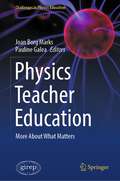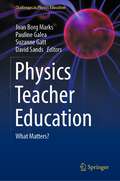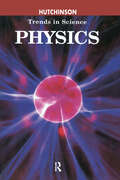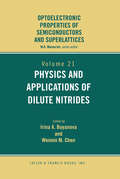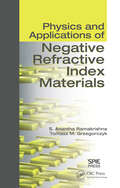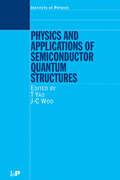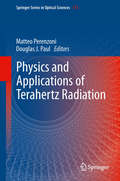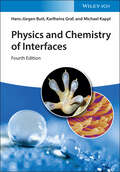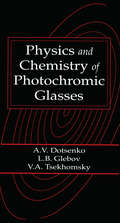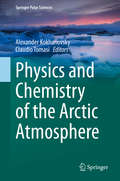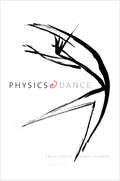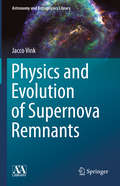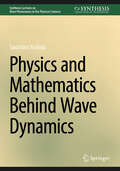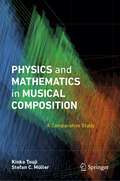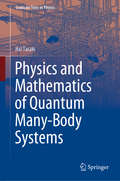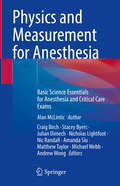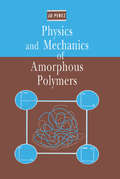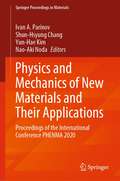- Table View
- List View
Physics Teacher Education: More About What Matters (Challenges in Physics Education)
by Joan Borg Marks Pauline GaleaThis book focuses on some important aspects of Physics Education: the role of metaphors in Physics teaching and learning, the connections between Physics and Mathematics, the interaction of young children with Physics at the primary level, and recent developments in teacher education in the USA. Contributors present their research related to: • Preparing teachers for TPACK (technological, pedagogical, and content knowledge) and laboratory work. • Developing and evaluating teacher PCK (pedagogical content knowledge) in Quantum Mechanics. • In-service Physics teacher education for early childhood and primary levels. • Pre-service Physics teacher education at all levels. • In-service Physics teacher professional learning for second and higher-level education. Chapters in this book inevitably look into how Physics teacher education is organized in different countries. Suggestions are offered for possible ways of supporting Physics teachers’ learning. An emphasis is made on the much-needed measurements of the effectiveness of different teaching strategies that improve teaching for learning.All this should help professionals, researchers, and pre-service, as well as in-service teachers to get acquainted with the most recent research contributions in the field.
Physics Teacher Education: What Matters? (Challenges in Physics Education)
by David Sands Joan Borg Marks Pauline Galea Suzanne GattThis book presents the most up-to-date research contributions focusing on progress in the field of physics education. It provides researches and results that are based on the most relevant matters in physics teacher education and how these matters can be improved for the satisfaction of both teachers and learners. The work is the by-product of the collaboration between GIREP (the International Research Group on Physics Teaching) and the University of Malta. The contributing authors present close examinations of the following topics: ICT and multimedia in teacher education; experiments and laboratory work in teacher education; the role of quantum mechanics in teaching and learning physics; formal, non-formal and informal aspects of physics education at the primary level; strategies for pre-service physics teacher education at all levels; and in-service teacher professional learning strategies. The editors hope that many different stakeholders within scientific academia will find something of value in this compilation of the current most advanced ideas in physics education.
Physics Trends (Trends in Science)
by Chris CooperToday's fast-moving world of science will have far-reaching effects on all of our lives. Trends inScience is a series of of essential readings for anyone who wants to know more about how his or her future will be affected; as well, the series provides accessible and stimulating material for high school and college students, for researchers and librarians.All titles in the series provide: an introductory overview of the field in the last 100 years, reviewing the past but also predicting the new developments of the future; a detailed chronology of the most important milestones; an index of key terms and concepts; biographies of the most important scientists in each field and their role in shaping their particular branch of science; a listing of important Websites, a directory of organizations, and suggestions for further reading.
Physics Volume-2 class 12 - Tamil Nadu Board
by State Council of Educational Research and TrainingThe textbook for class 12 Physics Vol-2 (English Medium) comprehensively covers advanced concepts in physics tailored for higher secondary students. It delves into crucial topics such as electromagnetism, optics, modern physics, and semiconductor devices, providing a strong foundation for students preparing for board exams and competitive entrance tests. Each chapter presents theoretical explanations, mathematical derivations, and real-world applications to enhance conceptual understanding. The book also includes numerous solved examples, practice exercises, and illustrations to facilitate learning and problem-solving skills. Designed to align with the prescribed curriculum, the textbook ensures a structured and systematic approach to physics, fostering analytical thinking and scientific reasoning among students.
Physics and Applications of Dilute Nitrides
by Irina A. Buyanova Weimin M. ChenSince their development in the 1990s, it has been discovered that diluted nitrides have intriguing properties that are not only distinct from those of conventional semiconductor materials, but also are conducive to various applications in optoelectronics and photonics. The book examines these applications and presents a broad and in-depth look at t
Physics and Applications of Hydrogen Negative Ion Sources (Springer Series on Atomic, Optical, and Plasma Physics #124)
by Marthe BacalThis book gives a comprehensive overview of hydrogen negative ion sources and their applications to particle acceleration and nuclear fusion. The book begins with fundamental aspects of negative ion production by volume and surface processes in hydrogen and its isotopes. It covers key topics, such as the need for separation of negative ion production and extraction regions, the need for lowering the work function of the plasma electrode by using caesium vapor or special materials for caesium-free sources, and the ion extractor structure required for hydrogen negative ion sources. Chapters covering various specific ion sources and applications are written by scientists who participated in their development and include sources for accelerators and for neutral beam injection into controlled nuclear fusion reactors.
Physics and Applications of Negative Refractive Index Materials
by S. Anantha Ramakrishna Tomasz M. GrzegorczykEver since the first experimental demonstration was reported in 2000, the interest in metamaterials and left-handed media that exhibit a negative refractive index has increased exponentially. Surveying this explosive growth, Physics and Applications of Negative Refractive Index Materials covers the fundamental physical principles and emerging engin
Physics and Applications of Semiconductor Quantum Structures
by Takafumi Yao Jong-Chun WooWritten by international experts, Physics and Applications of Semiconductor Quantum Structures covers the most important recent advances in the field. Beginning with a review of the evolution of semiconductor superlattices and quantum nanostructures, the book explores fabrication and characterization techniques, transport, optical, and spin-depende
Physics and Applications of Terahertz Radiation
by Matteo Perenzoni Douglas J. PaulThis book covers the latest advances in the techniques employed to manage the THz radiation and its potential uses. It has been subdivided in three sections: THz Detectors, THz Sources, Systems and Applications. These three sections will allow the reader to be introduced in a logical way to the physics problems of sensing and generation of the terahertz radiation, the implementation of these devices into systems including other components and finally the exploitation of the equipment for real applications in some different field. All of the sections and chapters can be individually addressed in order to deepen the understanding of a single topic without the need to read the whole book. The THz Detectors section will address the latest developments in detection devices based on three different physical principles: photodetection, thermal power detection, rectification. The THz Sources section will describe three completely different generation methods, operating in three separate scales: quantum cascade lasers, free electron lasers and non-linear optical generation. The Systems and Applications section will take care of introducing many of the aspects needed to move from a device to an equipment perspective: control of terahertz radiation, its use in imaging or in spectroscopy, potential uses in security, and will address also safety issues. The text book is at a level appropriate to graduate level courses up to researchers in the field who require a reference book covering all aspects of terahertz technology.
Physics and Astrophysics: Glimpses of the Progress
by Subal KarPhysics and Astrophysics—Glimpses of the Progress provides a comprehensive account of physics and astrophysics from the time of Aristotle to the modern era of Stephen Hawking and beyond. It takes the readers of all ages through a pleasant journey touching on the major discoveries and inventions that have taken place in both the macro-world, including that in the cosmos, and the micro-world of atomic and subatomic particles related to physics and astrophysics. Use of historical perspective and anecdote makes the storytelling on the progress of physics and astrophysics both interesting and absorbing. While peering through different developments in these fields, the book never compromises with the sanctity of the scientific content, including the depth and beauty of the physical concept of the topics concerned and the philosophical viewpoints they represent. Where appropriate, the book also delves into value judgments of life that affect our civilization. Features The intricate concepts of physics and astrophysics are explained in simple terms and in easy-to-understand language. Physics and astrophysics are discussed in a connected and correlated way in a single volume of comprehensive size but in totality, which to date is the unique feature of this book. Starting with Aristotle’s Physics and going through the work of Newton, Einstein, Schrödinger, Hubble, Hewish, Hawking, and others, including the present research on dark energy, dark matter, and the fifth force of nature, the reader will be kept absorbed and spellbound. In addition to the fundamental principles of Newtonian mechanics, Einstein’s relativity, quantum mechanics, string theory, loop quantum gravity, and so on, the cutting-edge technologies of recent times, such as the Large Hadron Collider, Laser Interferometer Gravitational-wave Observatory, and Event Horizon Telescope, are also explored. The book is aimed primarily at undergraduate and graduate students, researchers, and professionals studying physics and astrophysics. General readers will also find the book useful to quench their thirst for knowledge about the developments in physics and astrophysics.
Physics and Chemistry of Carbon-Based Materials: Basics and Applications
by Yoshihiro KubozonoThis book includes the fundamental science and applications of carbon-based materials, in particular fused polycyclic hydrocarbon, fullerene, diamond, carbides, graphite and graphene etc. During the past decade, these carbon-based materials have attracted much interest from many scientists and engineers because of their exciting physical properties and potential application toward electronic and energy devices. In this book, the fundamental theory referring to these materials, their syntheses and characterizations, the physical properties (physics), and the applications are fully described, which will contribute to an advancement of not only basic science in this research field but also technology using these materials. The book's targets are researchers and engineers in the field and graduate school students who specialize in physics, chemistry, and materials science. Thus, this book addresses the physics and chemistry of the principal materials in the twenty-first century.
Physics and Chemistry of Circumstellar Dust Shells
by Hans-Peter Gail Erwin SedlmayrCircumstellar dust, the astronomical dust that forms around a star, provides today's researchers with important clues for understanding how the Universe has evolved. This volume examines the structure, dynamics and observable consequences of the dust clouds surrounding highly evolved stars on the Giant Branch. Early chapters cover the physical and chemical basis of the formation of dust shells, the outflow of matter, and condensation processes, while offering detailed descriptions of techniques for calculating dust formation and growth. Later chapters showcase a wide range of modeling strategies, including chemical and radiative transfer and dust-induced non-linear dynamics, as well as the latest data obtained from AGB stars and other giants. This volume introduces graduate students and researchers to the theoretical description for modeling the dusty outflows from cool stars and provides a full understanding of the processes involved.
Physics and Chemistry of Interfaces
by Hans-Jürgen Butt Michael Kappl Karlheinz GrafPhysics and Chemistry of Interfaces Comprehensive textbook on the interdisciplinary field of interface science, fully updated with new content on wetting, spectroscopy, and coatings Physics and Chemistry of Interfaces provides a comprehensive introduction to the field of surface and interface science, focusing on essential concepts rather than specific details, and on intuitive understanding rather than convoluted math. Numerous high-end applications from surface technology, biotechnology, and microelectronics are included to illustrate and help readers easily comprehend basic concepts. The new edition contains an increased number of problems with detailed, worked solutions, making it ideal as a self-study resource. In topic coverage, the highly qualified authors take a balanced approach, discussing advanced interface phenomena in detail while remaining comprehensible. Chapter summaries with the most important equations, facts, and phenomena are included to aid the reader in information retention. A few of the sample topics included in Physics and Chemistry of Interfaces are as follows: Liquid surfaces, covering microscopic picture of a liquid surface, surface tension, the equation of Young and Laplace, and curved liquid surfaces Thermodynamics of interfaces, covering surface excess, internal energy and Helmholtz energy, equilibrium conditions, and interfacial excess energies Charged interfaces and the electric double layer, covering planar surfaces, the Grahame equation, and limitations of the Poisson-Boltzmann theory Surface forces, covering Van der Waals forces between molecules, macroscopic calculations, the Derjaguin approximation, and disjoining pressure Physics and Chemistry of Interfaces is a complete reference on the subject, aimed at advanced students (and their instructors) in physics, material science, chemistry, and engineering. Researchers requiring background knowledge on surface and interface science will also benefit from the accessible yet in-depth coverage of the text.
Physics and Chemistry of Nano-structured Materials
by Shihe YangThe development of nanostructured materials represents a new and fast evolving application of recent research in physics and chemistry. Novel experimental tools coupled with new theory have made this possible. Topics covered in this book include nanocrystals, semiconductor heterostructures, nanotubes, nanowires, and manipulation and fabrication tec
Physics and Chemistry of Photochromic Glasses
by Alexander V. Dotsenko Leonid B. Glebov Victor A. TsechomskyPhotochromic glasses are among the most widespread types of glasses, due largely to their popular use in sunglasses. These glasses are used not only in sunglasses, but also in various opto-electronic devices that have been developed and produced throughout the world. Until now, information about photochromic glasses has been widely dispersed in the literature, much of which was published in Russian and therefore of limited accessibility to the Western world. Physics and Chemistry of Photochromic Glasses brings together the combined knowledge and understanding of photochromic glasses from these publications. Coverage includes the structure, optical properties, coloration and bleaching mechanisms, technology, and metrology of these interesting materials.
Physics and Chemistry of Te and HgTe-based Ternary Semiconductor Melts
by Ching-Hua SuThis book reviews the experimental measurements of density, thermal conductivity, viscosity, and electrical conductivity on the binary, pseudo-binary melts of the most advanced IR-detector material systems of HgCdTe and HgZnTe as well as the theoretical analyses of these results. The time-dependent measurements on the relaxation behavior of the thermophysical properties during rapid cooling of the melts were also performed to elucidate the characteristics of the structural fluctuation and transition of the melts.The author shows his research results which extend understanding of the solidification process in order to interpret and improve the experimental results of crystal growth and enhances the fundamental knowledge of heterophase fluctuations phenomena in the melts so as to improve the melt growth processes of all the semiconductor systems.An in-depth study on the thermophysical properties and their time-dependent structural dynamic processes taking place in the vicinity of the solid-liquid phase transition of the narrow homogeneity range HgTe-based ternary semiconductors as well as the structural analysis of the alloy homogenization process in the melt is needed to understand and to improve the crystal growth processes.This book is intended for graduate students and professionals in materials science as well as engineers preparing and developing optical devices with semiconductors. The theory of heterophase fluctuations of liquids is applicable to any many-body systems including condensed-matter physics and field theory.
Physics and Chemistry of the Arctic Atmosphere (Springer Polar Sciences)
by Claudio Tomasi Alexander KokhanovskyThis book presents current knowledge on chemistry and physics of Arctic atmosphere. Special attention is given to studies of the Arctic haze phenomenon, Arctic tropospheric clouds, Arctic fog, polar stratospheric and mesospheric clouds, atmospheric dynamics, thermodynamics and radiative transfer as related to the polar environment. The atmosphere-cryosphere feedbacks and atmospheric remote sensing techniques are presented in detail. The problems of climate change in the Arctic are also addressed.
Physics and Dance
by Emily Coates Sarah DemersA fascinating exploration of our reality through the eyes of a physicist and a dancer—and an engaging introduction to both disciplines From stepping out of our beds each morning to admiring the stars at night, we live in a world of motion, energy, space, and time. How do we understand the phenomena that shape our experience? How do we make sense of our physical realities? Two guides—a former member of New York City Ballet, Emily Coates, and a CERN particle physicist, Sarah Demers—show us how their respective disciplines can help us to understand both the quotidian and the deepest questions about the universe. Requiring no previous knowledge of dance or physics, this introduction covers the fundamentals while revealing how a dialogue between art and science can enrich our appreciation of both. Readers will come away with a broad cultural knowledge of Newtonian to quantum mechanics and classical to contemporary dance. Including problem sets and choreographic exercises to solidify understanding, this book will be of interest to anyone curious about physics or dance.
Physics and Evolution of Supernova Remnants (Astronomy and Astrophysics Library)
by Jacco VinkWritten by a leading expert, this monograph presents recent developments on supernova remnants, with the inclusion of results from various satellites and ground-based instruments. The book details the physics and evolution of supernova remnants, as well as provides an up-to-date account of recent multiwavelength results. Supernova remnants provide vital clues about the actual supernova explosions from X-ray spectroscopy of the supernova material, or from the imprints the progenitors had on the ambient medium supernova remnants are interacting with - all of which the author discusses in great detail. The way in which supernova remnants are classified, is reviewed and explained early on. A chapter is devoted to the related topic of pulsar wind nebulae, and neutron stars associated with supernova remnants. The book also includes an extended part on radiative processes, collisionless shock physics and cosmic-ray acceleration, making this book applicable to a wide variety of astronomical sub-disciplines. With its coverage of fundamental physics and careful review of the state of the field, the book serves as both textbook for advanced students and as reference for researchers in the field.
Physics and Mathematics Behind Wave Dynamics (Synthesis Lectures on Wave Phenomena in the Physical Sciences)
by Sanichiro YoshidaMost physical phenomena exhibit spatiotemporal features interpreted as wave dynamics. Various diagnostic technologies use some waves such as light, sound, and microwaves. A proper understanding of wave dynamics is essential to interpret these physical phenomena and apply the technology efficiently. However, the physics underlying the wave-like behavior of real-world systems is not necessarily straightforward. Often the mathematical description of these physics is hard to understand. Consequently, the interpretation of diagnostic signals is not simple, which sometimes leads to an incorrect diagnosis. This book aims to solve these problems by describing the related topics on a sound physical basis and explaining them intuitively for easy digestion. Presents real-world examples of oscillatory and wave systems to help the reader understand wave dynamics while explaining numerical methods. Explains the physics and mathematics underlying wave dynamics in intuitive fashions.
Physics and Mathematics in Musical Composition: A Comparative Study
by Stefan C. Müller Kinko TsujiHow is music born? Is music made by humans or does it already exist and wait to be found? How do composers create (or find) music? Having these questions in mind the authors ask more questions: How can we share our feelings with other people when listening to music? Can these be visualized? Why did Helmholtz have a problem with the third? Why is precise tuning so important in European music and less so in other cultures? What are the differences among the continents? What makes dissonant tone intervals uncomfortable in many cases? What enables us to distinguish the music of Mozart from that of Beethoven? Why are we fascinated by birdsong? Why does some music survive, whereas other just disappears? And finally, along which lines will music develop in the future? Drawing upon physics and mathematics, the authors search for answers to these questions and attempt to unravel in some depth the enigmas of how our minds are affected by the perception of music.
Physics and Mathematics of Quantum Many-Body Systems (Graduate Texts in Physics)
by Hal TasakiThis book is a self-contained advanced textbook on the mathematical-physical aspects of quantum many-body systems, which begins with a pedagogical presentation of the necessary background information before moving on to subjects of active research, including topological phases of matter. The book explores in detail selected topics in quantum spin systems and lattice electron systems, namely, long-range order and spontaneous symmetry breaking in the antiferromagnetic Heisenberg model in two or higher dimensions (Part I), Haldane phenomena in antiferromagnetic quantum spin chains and related topics in topological phases of quantum matter (Part II), and the origin of magnetism in various versions of the Hubbard model (Part III). Each of these topics represents certain nontrivial phenomena or features that are invariably encountered in a variety of quantum many-body systems, including quantum field theory, condensed matter systems, cold atoms, and artificial quantum systems designed for future quantum computers. The book’s main focus is on universal properties of quantum many-body systems. The book includes roughly 50 problems with detailed solutions. The reader only requires elementary linear algebra and calculus to comprehend the material and work through the problems. Given its scope and format, the book is suitable both for self-study and as a textbook for graduate or advanced undergraduate classes.
Physics and Measurement for Anesthesia: Basic Science Essentials for Anesthesia and Critical Care Exams
by Matthew Taylor Andrew Wong Michael Webb Craig Birch Stacey Byers Julian Dimech Nicholas Lightfoot Nic Randall Amanda SiuAnesthesia is a practical, clinically based medical science. Its conduct requires Anesthesiologists and Intensivists to learn and understand the principles of applied physics related to equipment responsible for the clinical care of patients. This book is written primarily for anesthetic registrars/residents and their teachers, to assist with preparation for the post graduate, basic science examinations in anesthesia and critical care medicine. Each topic is systematically covered using first principles, contextual examples, and illustrations to explain and demonstrate complex concepts. This comprehensive book is an up-to-date compilation of these scientific principles that can easily be applied to any operating theatre or intensive care unit around the world.
Physics and Mechanics of Amorphous Polymers
by Jo PerezTopics covered in this text include: structural aspects of polymers; molecular mobility in amorphous solid polymers; non-elastic deformation of solid amorphous polymers; mechanical experiments; interpretation of results; physical ageing of amorphous polymers; and glass transition.
Physics and Mechanics of New Materials and Their Applications: Proceedings of the International Conference PHENMA 2020 (Springer Proceedings in Materials #10)
by Shun-Hsyung Chang Ivan A. Parinov Yun-Hae Kim Nao-Aki NodaThis book presents selected peer-reviewed contributions from the 2020 International Conference on “Physics and Mechanics of New Materials and Their Applications”, PHENMA 2020 (26–29 March 2021, Kitakyushu, Japan), focusing on processing techniques, physics, mechanics, and applications of advanced materials. The book describes a broad spectrum of promising nanostructures, crystal structures, materials, and composites with unique properties. It presents nanotechnological design approaches, environmental-friendly processing techniques, and physicochemical as well as mechanical studies of advanced materials. The selected contributions describe recent progress in computational materials science methods and algorithms (in particular, finite-element and finite-difference modelling) applied to various technological, mechanical, and physical problems. The presented results are important for ongoing efforts concerning the theory, modelling, and testing of advanced materials. Other results are devoted to promising devices with higher accuracy, increased longevity, and greater potential to work effectively under critical temperatures, high pressure, and in aggressive environments.
